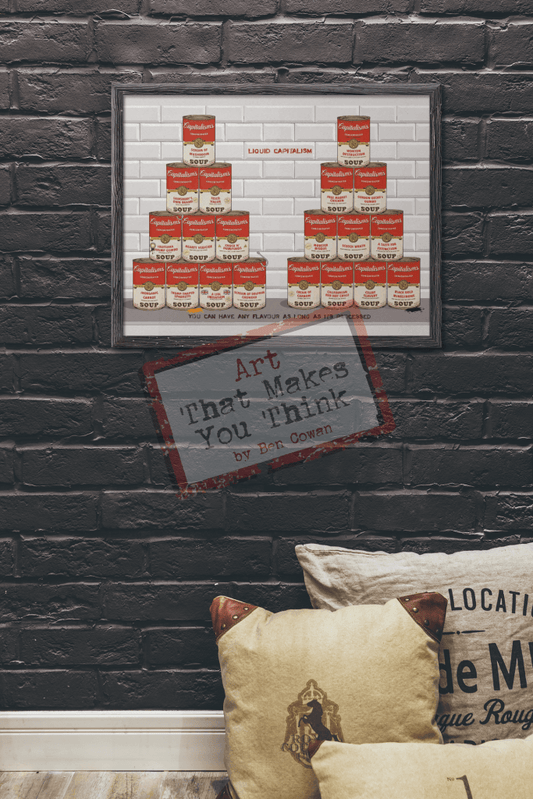We're led to believe that there's a hierarchy in art. You know, fine art - that's the best; mass-produced art - that's no better than advertising; and digital art – well, anyone can do that, right?
Maybe there is a hierarchy, there are gallery curators and online influencers, and there is the art that people like on the street, or sofa. You will see plenty of 'original' works in exhibitions that are distinctively average; instances of 'fine art' bereft of ideas. In the 1960s, Andy Warhol challenged the idea that art which is mass-produced (screen printed) concerning a mass-produced product (soup can labels) wouldn't appeal to art collectors.
Digital art is ubiquitous, but can also be incredibly creative, and is part of our inescapable future, both for commercial and artistic purposes. The rise of non-fungable tokens (NFTs) with sales for tens of millions shows that there is value for collectors in making a digital file unique either through block-chain or other algorithms. Of course, there's inflated hype by auctioneers and celebs, but that's not something that the art industry has sought to avoid before. Anything that involves Paris Hilton, I usually avoid, but the digital artist, Michael Winkleman (Beeble crap) has recently produced some joyful satire following his NFT sale of ‘Everydays’ for $69m in 2021.
Where do I sit? Why listen to me? What I would like to do, above all, is to create art that makes you think about the wider world and where it is going. I'm not wedded to digital - I'd love to use aerosol spray cans with stencils, mixed media and the like. For now, I'm not into NFTs, but then I’m not sure I really understand them, or know how to connect with the world through them to access a bigger market for my work. One day perhaps, when the froth and vapour has evaporated a little, and I have missed my big splash opportunity on the world stage.
What I do believe in is the idea that the medium - with which an artist works - speaks to them. It is the role of an artist to respond to what the medium needs to be. I also believe that art, as well as upcycled objects, such as my lighting sculptures, have a ‘natural home’, shape, form and even function.
In my case, the 'natural home' for a lot of my designs is to be worn, to be carried, or to be hung in the home; although not necessarily printed on paper and pressed within reflective frames. For this reason, I have partnered with Redbubble to create a shop with hundreds of products, which feel appropriate for my designs. Perfect as gifts, especially for those who have limited space for non-practical things, like art...
At the heart of my 'Merch' range, is this ironic definition T-shirt. If much of my art is about showing you one thing that means the opposite - so that you might reflect on why all is not as it seems - then let’s get a definition out there for what irony is, and then of course, I will subvert it…
A natural way of doing this is not to define irony, we have dictionaries for this, but to imagine a definition of an 'ironic T-shirt' and then draw on dramatic irony to subvert. A good starting point for dramatic irony is Ancient Greece, where all things 'Western' begin. In a Greek play, the protagonist might not know that they were in a tragedy, comedy, or farce... because as the Socratic quote goes, “The only man who knows is the man who does not know…”
So one ironic T-shirt definitions in the Ideas Worth Wearing collection reads:
The use of words to convey a meaning on wearable cotton material, that is the opposite of its literal meaning, often not grasped by the wearer.
You can work it out for yourself, but I love the idea that the wearer may not know that the ironic T-shirt that they have gone out and bought and are now wearing, is ironic. That's ironic. Dramatically ironic.
I know what you are thinking, that’s a bit meta Ben; it’s just a t-shirt. From my point of view, a brand is just a brand. To some people it’s more. For marketing staff, their inflated salaries depend on that belief. If a brand emblazoned on someone’s chest is seen by everyone they meet, it can pass a message. For me, the message is that capitalism is the world’s religion and private space has been made public to serve corporations. Instead, the message could help people to think. A statement or image that defines the wearer as someone who does not subscribe to this religion and by contrast is an independent thinking outsider.
This concept of subverting followship is central to observational comedy, and to artistic people the world over. If we flock, are we not sheep? If a sheep does not flock, is it a sheep? And who is the shepherd in this…field anyway? This is the subject of Ceci n’est pas un mouton t-shirt and my next Ideas Worth Sharing blog, so more on that next time...blah, blah, baa, baa.

Please share your ideas and your thoughts on the above, in the box below or reply to the email.
Never unknowingly ironic
[insert joke here]





